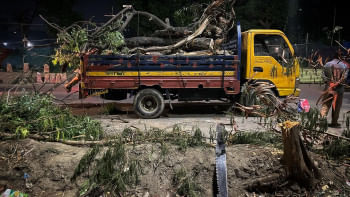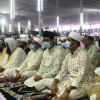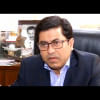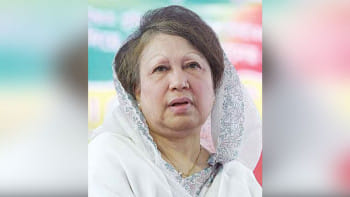‘Aggression from government, private bodies a huge challenge for us’

In an exclusive interview with The Daily Star, Dhaka South City Corporation (DSCC) Mayor Sheikh Fazle Noor Taposh talks about the current state of playground and parks, tree felling for development purposes, and the importance of public opinion in designing projects.
Beautiful Dhaka – with playgrounds, greenery and parks – was one of your five electoral pledges. However, we have been observing a distressing trend of key public parks, such as Osmani Udyan and Panthakunja Park, remaining off limits to the public due to never-ending construction work. Why this long delay in ensuring people's access to parks?
In my election manifesto, I categorically mentioned that we want to bring back ward-based playgrounds. Even if we can find just a small piece of land, we'll turn it into a playground for children. For instance, in Sutrapur, under Ward 42, which is a densely populated area in Old Dhaka, a small piece of land of the DSCC was leased in the name of establishing a car park and market. But they were essentially occupying the land for years, even after a case had been filed with the High Court. I recovered the land from encroachers, disposed of the case, and made the land accessible for children. In Alamganj, under Ward 46, we recovered a piece of PWD land – which had been encroached upon from every side and turned into a warehouse of sorts – from the encroachers and erected a fence around the playground.
As for the parks you mentioned, they are being constructed under megaprojects, but it is sad that for various reasons, the work has been delayed. Just after I took over as mayor, I visited Osmani Udyan thrice and tried to fast-track its completion. But unfortunately, the contractor violated the terms and conditions of our contract, and we had to cancel it. Now, we are going for implementation based on the original design. But three years of my tenure have already passed. Appointing new contractors after doing due diligence is a lengthy process.
Our project at Panthakunja had to be suspended due to the construction plan of the elevated expressway. Many unnecessary infrastructures had been planned in the earlier designs of the expressway, so we had to ask them to revise the designs to showcase the natural beauty instead. But, again, we had to cancel the contract and we will have to invite a fresh tender for it. We are hoping to resume the work of both parks this year and complete them within a short time.
You are saying that you have taken many initiatives to ensure parks and playgrounds in every ward, but we have seen some government organisations occupying and constructing housing projects on some of these playgrounds. In Azimpur, for instance, three playgrounds were gobbled up to construct high-rise buildings. According to the Detailed Area Plan, 25 wards of DSCC are still without any playgrounds.
Aggression is a huge challenge for us – aggression from land-grabbers, private organisations, and government bodies too. You will be surprised to hear that in Ward 11, Rab was going to build an office occupying a DSCC playground. The agreement had been signed just before I took over office. I told them that they cannot take over a playground.
But we are also taking proactive steps. We have spoken to the deputy commissioner and asked him to identify government land, particularly in 18 new DSCC wards, so that we can build sufficient playgrounds in a planned manner. We are constructing the Dhupkhola playground. We have opened Golapbag playground and Sadeque Hossain Khoka playground for the public. So, we are doing our work at a time of tremendous aggression.
In Dhanmondi, why have most of the public playgrounds been leased out to private clubs, barring access to the public? Dhanmondi Lake has been leased out to various businesses, most of whom are violating their lease by not doing due maintenance of the parks. Are you concerned about it?
The playgrounds we are constructing or renovating will remain open for all round the clock. But we are also seeing that some of the playgrounds, particularly in posh areas, are being run by different academies. The Dhanmondi Sheikh Jamal playground is operated by Sheikh Jamal Club, and it was leased out to them before my time. The Abahani field, too, has been under the Abahani Club for a long time – since the 70s, in fact. But the Abahani field is still open to the people, as far as I know. The construction work that is going on now is on the land that belongs to Abahani to expand their facilities.
In many cases, parks and playgrounds were reduced in size when renovated under megaprojects as part of their design – it was done by urban planners themselves. Under these projects, new structures were introduced to be run commercially to ensure the maintenance of the parks. The design of Dhanmondi Lake was prepared in 1996, after the Awami League government came to power. And we still have the same infrastructures that were initially in the master plan – nothing new has been added. Those who took the lease before ran those establishments but did not pay the DSCC for 14 years. I cancelled those leases and gave out new ones, maintaining the same conditions.
People in Dhaka have limited places to visit, and everyone wants to visit Dhanmondi Lake. So even though people complain to me all the time that there are too many people there, we can't really help it. However, we want to keep all the parks, udyan and public places under the DSCC closed for one day of the week for due maintenance and cleaning.
We have formed a committee to maintain these parks, playgrounds and public places. Earlier, everything would be done based on a given project, which meant that as soon as the project ended, there was no one to ensure its maintenance. City corporations also did not focus on maintenance work. As we have the financial capacity now, we are prioritising this issue. We have appointed an arboriculturalist, caretakers and new gardeners to maintain the greenery and aesthetics of the spaces. We are building our capacity.
People in Dhaka have limited places to visit, and everyone wants to visit Dhanmondi Lake. So even though people complain to me all the time that there are too many people there, we can't really help it. However, we want to keep all the parks, udyan and public places under the DSCC closed for one day of the week for due maintenance and cleaning.
There have been widespread protests and criticisms about the tree felling on Satmasjid Road. Although urban planners and environmentalists have said the development work could have been done without harming the trees, you have insisted that the action was inevitable.
People can make a lot of generalised comments. We also have our own experts and urban planners, and we have designed the projects based on their recommendations. We do not want to fell trees unless it is absolutely necessary. Even then, if some trees have to be cut for development purposes, we make sure to plant three times as many trees. You have seen how many plants we have already planted on Road 27. Basically, we want to replace big trees with smaller flower plants in the medians, which increase the aesthetics and are also easier to maintain.
Shundor Dhaka is one of our electoral pledges. We have planted over 300,000 plants, but unfortunately, no one listens when you beat your own drum.
As a city mayor, how important is public opinion to you? Is there any mechanism in place to inform the public and engage them in consultations before major decisions are made about development work?
We give utmost importance to public opinion. Every time we undertake a project, our consultants and directors are supposed to visit the locality and engage with community members, and design the projects based on their concerns and recommendations. It's not as if a project is designed from a mayor's office! Unfortunately, I have found that a lot of our external consultants didn't actually make the field visits before designing the projects – they did so from the comforts of their offices, on their laptops. As a result, many of those designs were flawed and completely devoid of the grassroots reality. However, we have begun the process of consulting the public.
There are many projects where we have taken the perspective of the local communities into consideration before finalising the details. Sometimes, when we tell the experts that we want an aesthetic and beautiful space, they come back to us with elaborate designs where there are costly structures with only a few trees here and there. But then we hear from the communities that they do not want such obstructions – they want open, unrestricted green space. And we definitely prioritise people's concerns.
So, you are saying that when there is a protest from a given community about one of DSCC's projects, you revert your decision based on people's demands?
Yes, there are many such examples. But you also have to see where the resistance is coming from. When I went to excavate the Buriganga, land-grabbers naturally resisted. You can't pay heed to their resistance. We went to the field, we inspected CS, RS, SA blueprints, RA blueprints, field survey blueprints, GIS maps, etc before we went for implementation. If someone comes and says their grandfather left them land in the middle of the river, I can't accept that. Of course, I have to take a stern stance then.
In the last one-and-a-half decades, Tk 115 crore was spent on setting up modern traffic signal lights, but people did not get any benefit from it. Now, the DSCC is going to set up AI technology at 54 spots to modernise traffic signals. Experts think this kind of technology is not viable for Dhaka city where the volume of traffic is huge. What do you think?
I am also concerned about the project's success. We are going to implement this work in two phases. In the first phase, we need some infrastructural development, such as expanding roads, balancing the lanes and ensuring pedestrian-friendly footpaths. There are some other roads which are not of the same width throughout, meaning some parts are narrower than others, which create traffic congestion. In the second phase, synchronised traffic signals will be introduced, which was not done earlier.
We will definitely do a pilot project before going for synchronisation. Besides, the remote control that was given to the police previously was not synchronised, and they could control the signals manually through the remote. After a while, they just returned to their old system of using sticks. We will set up a central control room through which to control the entire signalling system. If we become successful, then Dhaka will get a modern traffic movement system after a long time.

 For all latest news, follow The Daily Star's Google News channel.
For all latest news, follow The Daily Star's Google News channel. 










Comments